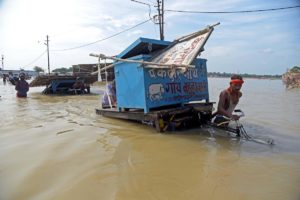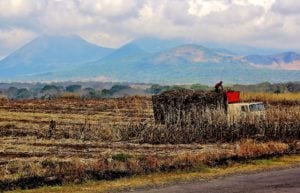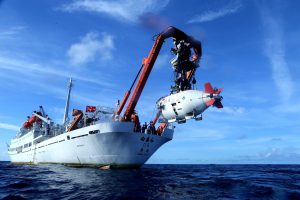The floods in Assam and Bihar and the cloudburst in Chamoli district of Uttarakhand have all once again underlined the risk of developing hydropower in the Himalayas. On top of that, over the last few years increasing evidence has emerged that hydropower production may not be as clean and green as claimed. While most of this research has highlighted that the cascade of hydropower projects stops the free flow of rivers, the issues of environmental hazards and risks that accompany the construction of hydropower have not been highlighted enough.
The Hidden Cost of Hydropower: environmental hazards and risks of tunnelling, excavation and construction in Run of the River Hydropower Projects in Himachal Pradesh, a recent report compiled by Himdhara, an Environment Research and Action Collective, addresses this gap.
For the last decade, Himdhara has been tracking and documenting the impacts of construction of hydropower projects in Himachal Pradesh, the highest producer of hydropower in the country today, with installed capacity of over 10,500 MW.
The report is a compilation of some primary and secondary evidences of the impacts triggered by construction of tunnels and other underground components for hydropower projects in the state. First and foremost, it is clear that building hydropower projects in the Himalayas is a due to the existing geological and ecological vulnerability of the mountain range itself.
For instance, 97.42% of the total geographical area of Himachal Pradesh is prone to landslides, according to the Geological survey of India. A Landslide Hazard Risk Assessment study published by the Himachal government’s own Disaster Management Cell found that a huge number of hydropower stations are under threat of landslide hazard risk and at least 10 mega hydropower stations are located in medium and high-risk landslide areas.
A research study released in 2018 by the Institute of Earth and Environmental Science in Germany concluded that one in four hydropower projects in the Himalayan region are at risk from landslides triggered by earthquakes and tremors. The report cites examples to illustrate how risks of accidents around hydropower project sites are higher due to climate change related disasters like flash floods and cloudbursts.
Second, the Himdhara report explains that the underground component of the civil work in hydropower projects is quite substantial, involving blasting and dynamiting which exacerbate existing vulnerabilities and unleash impacts that are yet to be adequately studied and understood. Underground construction includes a headrace tunnel large enough to allow the passage of heavy vehicles, a tailrace tunnel, a surge shaft like a deep well, a powerhouse, transformer hall, desilting chambers and adit tunnels to provide access for the construction of the main tunnel.
The report highlights four major impacts of this kind of construction:
- Geological impacts – triggering of landslides/slope failures leading to damage of roads, farms, houses;
- Hydrogeological impacts – drying of springs and underground water sources;
- Muck dumping along rivers leading to increasing siltation in forests and pastures;
- Safety negligence leading to accidents
To make its points, the report provides visuals from project sites in Kinnaur, Kullu and Chamba falling in the Satluj, Beas and Ravi river basins respectively. Case studies like that of the Parbati II, Karcham Wangtoo, Kashang and Bajoli Holi projects illustrate how these impacts have made difficult the lives and livelihoods of the people in the project area. Glaring loopholes in the planning, impact assessment and regulatory mechanisms are seen in each of the cases presented.
Most important, the report says that existing studies available on these impacts are inadequate or biased in favour of the hydropower producers, with economics as the main concern. For instance, environment impact assessment reports of hydropower projects have detailed sections on the geological and seismic vulnerability of the project sites, but these seem to be glossed over with an explanation that the “hurdles”, “surprises” and “incompetencies” of mountain geology would be handled and mitigated at a later stage, if and when they occur. Absence of baseline data makes it difficult to establish scientific linkages between tunnel construction and damage to houses, but at the time of impact assessment studies there is a rush to complete the studies to get speedy clearances.
The costs of these “surprises” are externalised and borne by the affected people or the public exchequer to a large extent. Reports of the Comptroller Auditor General provide ample evidence of this. The costs that producers have been forced to bear have led to financial losses and bad loans and cumulatively a slump in the hydropower sector over the last few years. While revenues have been falling at the state level, at the national level the contribution of hydropower sector to the country’s total electricity production has halved from 25% to 13% in the last decade. While vagaries of the energy sector are partly responsible for the depleting demand and rising cost of hydropower, these local factors are also playing a role.
The Himdhara report identifies the institutional failures of the Central Water Commission and the Central Electricity Authority that are supposed to assess the detailed project reports, give techno-economic clearances and monitor the progress and reasons for delay in projects. It finds that the environment ministry has granted environment and forest clearances overlooking these impacts and non-compliances. It also finds that the Himachal Directorate of Energy and State Disaster Management Authority have failed to fulfil their regulatory roles to ensure that there is no negligence.
Apart from the lack of governance, there is a major policy failure that led to the recommendation by India’s Parliamentary Standing Committee on Energy that all hydroelectricity projects above 25 MW would also be considered as “renewable”, and thus eligible for further subsidies. This would mean that more costs are transferred to the ecology and affected people.
Need of the hour
The need of the hour is a pause on hydropower in the Himalayas in order to stop further devastation. There needs to be a complete stop to subsidies to the hydropower sector based on the ‘green’ tagging. The ‘renewable’ tag for hydropower needs to go.
An independent scientific review or assessment of the immediate or long-term implications of construction work for hydropower development especially in the Himalayas should be commissioned. A revision of terms of reference of impact assessment studies should be done on the basis of this.
There should be an independent inquiry or audit of the social, environmental and safety norms compliance of all under-construction and operational projects, specifically projects where accidents have already been reported. Himachal needs an independent dam safety cell that will have members from all concerned departments. India needs a dam safety law.
Citizens’ engagement and public consent mechanisms need to be strengthened at the planning stage and a grievance redressal mechanism for addressing issues brought forth by public needs to be put in place post clearance.
![<p>The Karcham Wangtoo hydropower project site at Kinnaur district, Himachal Pradesh , India [Image by: Wikimedia Commons]</p>](https://dialogue.earth/content/uploads/2019/08/Karcham-Wangtoo-hydropower-project-scaled.jpg)







